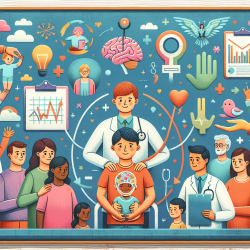Introduction to OGT-CDG and Its Implications
The research paper titled "O-GlcNAc transferase congenital disorder of glycosylation (OGT-CDG): Potential mechanistic targets revealed by evaluating the OGT interactome" provides valuable insights into the genetic and biochemical underpinnings of OGT-CDG, a disorder characterized by intellectual disability and developmental delays. Understanding these mechanisms is crucial for speech-language pathologists (SLPs) who aim to develop data-driven therapeutic strategies for affected children.
Understanding OGT-CDG
OGT-CDG is linked to mutations in the O-GlcNAc transferase (OGT) enzyme, which is essential for the post-translational modification of proteins involved in neural development. This disorder primarily manifests as intellectual disability and developmental delays, often affecting speech and language development. The variability in phenotypic expression among patients suggests a complex interaction of genetic and environmental factors.
Insights from the OGT Interactome
The OGT interactome, a network of proteins interacting with OGT, is enriched with proteins implicated in neurodevelopmental disorders. This network provides potential targets for therapeutic intervention. Key proteins within this interactome are involved in transcription regulation, chromatin remodeling, and histone modification, all of which are crucial for proper neural development.
Implications for Speech-Language Pathologists
SLPs can leverage the findings from the OGT interactome to tailor interventions that address the specific neurodevelopmental challenges faced by children with OGT-CDG. By understanding the molecular mechanisms at play, SLPs can develop targeted therapies that may improve cognitive and communicative outcomes.
- Focus on interventions that enhance neural plasticity and support cognitive development.
- Incorporate strategies that stimulate language development through enriched environments and interactive communication.
- Collaborate with geneticists and neuroscientists to stay updated on emerging therapeutic targets and interventions.
Encouraging Further Research
While the current research provides a foundational understanding of OGT-CDG, further studies are needed to explore the full spectrum of phenotypic variability and therapeutic efficacy. SLPs are encouraged to engage in interdisciplinary research that bridges the gap between molecular biology and clinical practice.
Conclusion
By integrating insights from the OGT interactome, speech-language pathologists can enhance their practice and contribute to improved outcomes for children with OGT-CDG. This approach underscores the importance of data-driven decision-making in developing effective therapeutic strategies.
To read the original research paper, please follow this link: O-GlcNAc transferase congenital disorder of glycosylation (OGT-CDG): Potential mechanistic targets revealed by evaluating the OGT interactome.










